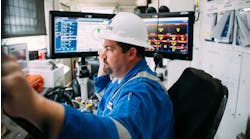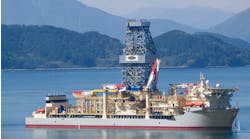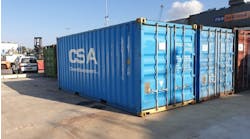LAM/Zhdanov overhaul program lifts production off Turkmenistan
Jeremy Beckman, Editor, Europe
Production activity is heating up off Turkmenistan. In nearshore Block 1, Petronas Carigali is about to start an extended well test via a specially modified jackup platform.
In the adjacent Cheleken contract area, Dragon Oil’s long-time redevelopment of the LAM and Zhdanov fields is entering a new phase. New platforms and processing facilities should allow the company to more than double oil output to 50,000 b/d.
The Cheleken acreage extends over 950 sq km. Zhdanov (Dzhygalybeg) and LAM (Dzheitun) were discovered respectively in 1967 and 1972. Both are elongated oilfields with associated gas, in water depths ranging from 10-37 m. They were partially developed by Soviet contractors between the mid-1970s and late ‘80s by over 115 wells, with production sent to the Turkmen coast for processing.
At that time, the offshore crude was mixed with crude from the onshore Cheleken field and processed at central gas-oil separation and oil-water separation facilities located at Cheleken. By 2001, however, only 16 of the Soviet era wells were still in service, producing cumulatively less than 8,000 b/d.
Following the breakup of the Soviet Union, Larmag Energy Assets, a Dutch independent oil producer, took charge of development in a joint venture with Turkmen state oil company Turkmenneft. Dragon Oil bought part of Larmag’s interest in the joint venture in 1993, acquiring 100% interest four years later. Emirates National Oil Co. Ltd. LLC (ENOC) owned by the government of Dubai, UAE, acquired a controlling interest in Dragon Oil in 1998.
Dragon signed a production-sharing agreement (PSA) with the government of Turkmenistan that became effective in 2000. The PSA’s duration - 25 years, with the possibility of a 10-year extension - reflects the fields’ untapped potential. In June 2005, proven and probable reserves were nearly 658 MMbbl of oil, with best estimate contingent gas resources of 3.5t cf.
Today, technical engineering and planning is conducted from Dragon’s base in Dubai, while the company’s field operations and logistics base is in Hazar, Turkmenistan. Dragon has also retained a country office in the capital Ashgabad.
When Dragon took the reins at LAM/Zhdanov, most of the existing platforms were either abandoned or in need of major upgrades. Some of the unserviceable facilities were still connected to live wells, forcing the company into a systematic program of platform and well decommissioning. Management had to balance the costs of this program - potentially debilitating for a company Dragon’s size - with the need to raise revenue through increased production.
Having secured financing loans from international banks and major shareholder ENOC, Dragon started development drilling from the revamped LAM 22 platform in June 2001, using the modified land rigRig 40 owned by the company and operated by Deutag. Over the next 18 months, it fulfilled its target of five wells, in the process raising total oil output above 15,000 b/d.
Then as now, production in this landlocked region was sold under swap arrangements. The oil is shipped in tankers to the Caspian Sea ports of Neka in Iran and Baku. The associated gas is brought onshore to provide energy for the local community and industry at Cheleken, and the balance is flared offshore.
During 2002, Dragon completed studies relating to refurbishment of the LAM 21 platform, ahead of the next planned development campaign. The topsides were refurbished the following year, to allow production from the planned four new platform-based wells to flow through both an existing subsea pipeline, and a parallel line, 8-in. in diameter. The latter was installed in 2004.
For the drilling program, Dragon contracted the jackupAstrafrom Lukoil Shelf. According to a company spokesman, “We went for a jackup this time because of the reduced refurbishment time and costs, and also due to the different subsurface targets.” The rig was also contracted provisionally to drill wells from LAM 10, the next scheduled upgrade project.
In the meantime, Dragon decided to up the pace of oil recovery by commissioning engineering studies for a brand-new wellhead and production installation, LAM A. It also raised further equity to fund a 3D seismic survey over the contract area, the twin aims being to clarify the reservoirs’ internal architecture, and to identify new drilling targets.
The seismic was acquired early in 2005 using an ocean bottom cable spread with a 4,750-m maximum offset, 50-m cable spacing and a 25-m group interval. Altogether, 654 sq km of new data were compiled, subsequently processed by CGG and interpreted in-house by Dragon. Some of the processing/interpretation was fasttracked, to select the optimum location for LAM A. The full interpretation/re-mapping exercise should be completed later this year.
Development drilling from LAM 21 started in November 2003. In all, five wells were drilled, completed, and put on production by December 2004. Of these, the most productive was LAM 21/109, which tested oil at a combined rate of 5,330 b/d from six zones. It was also the first well to penetrate zones 10 and 11, with a total depth of 4,670 m. Another well, LAM 21/108, encountered over 80 m of gas/condensate reservoirs in zone 4.
For this program, Dragon employed a rotary steerable system for directional drilling - all previous directional work on the fields had involved slower, conventional positive displacement mud motors. In general, the spokesman adds, “our well engineering approach has focused on methods to perforate and produce as many reservoir layers as possible.
“Only one reservoir zone was produced at any time in the Soviet-era wells, whereas our approach involves the application of multi-packer and - more recently - dual completions. These are designed to accelerate production since more reservoir zones can be perforated and produced simultaneously.”
Dual completions feature in the last two wells of the six-well LAM10 program, which started late in 2004. The first well, LAM 10/110, was also deepened to zones 11 and 12. Although these zones tested water, Dragon believes they contain significant oil potential and plans a further evaluation in 2006 at an up-dip location.
After completing LAM 10/110, theAstra made way for North Drilling Co.’s jackup Iran Khazar, which resumed the work on the remaining wells in this program last spring. Dragon is also hoping to contract more rigs to speed up development drilling on LAM/Zhdanov, as new processing capacity becomes available.
Lately, the company has been eking out further oil through a series of workovers on some of the fields’ older wells. This campaign started in mid-2004, using a combination of rigless perforation techniques and a hydraulic workover unit, the latter supplied by Calgary-based High Arctic Energy Services. Late last year, Dragon mobilized a second unit to Cheleken for operation on Zhdanov field, provided in this case by Cudd Pressure Control of Houston.
An EPC contract for the LAM A platform was awarded to Ukrainian contractor NCGS, with Germanischer Lloyd as the certifying authority. LAM A should be installed and commissioned late this year and will feature eight well slots, each designed to accommodate dual completions. Dragon is also constructing a new processing facility in Cheleken which is designed and built by Ukrgazpromstroy of the Ukraine. This new facility will be able to process oil water separation and storage of up to 50,000 b/d from the two fields and should be commissioned by mid-year.
Following the completion of the 3D seismic interpretation/re-mapping exercise, Dragon’s next priorities will be to assess new drilling targets and to explore commercial outlets for the fields’ gas.•






